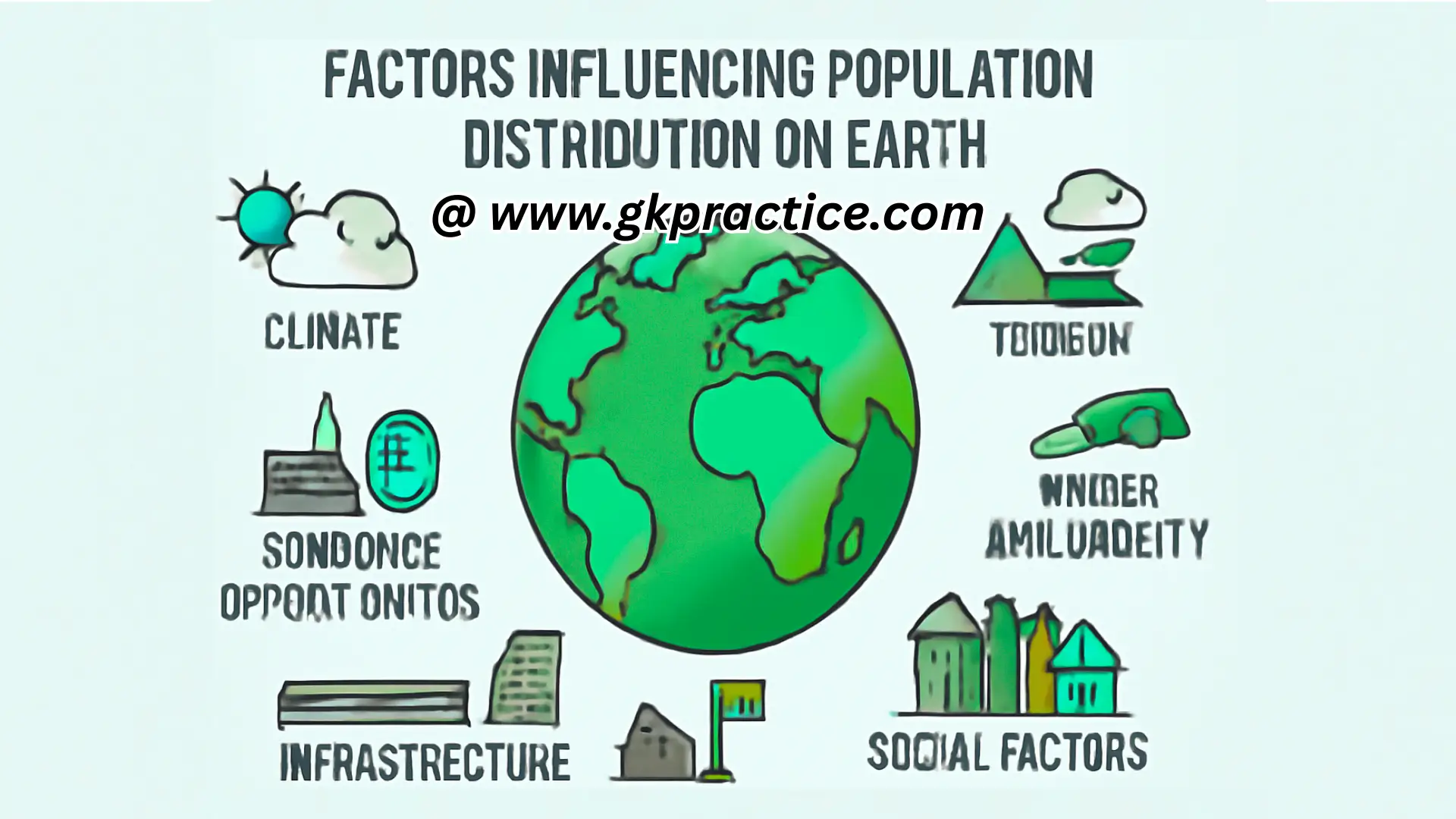Explore the most important Factors Influencing Population Distribution General Knowledge Questions from Human Geography with detailed explanations. Perfect for UPSC, SSC, Railway, Banking, and State PSC exams. Strengthen your Geography GK preparation with these practice questions.
Here Are Some Important Factors Influencing Population Distribution General Knowledge Questions for Competitive Exams:-
Q1. Which physical factor most strongly influences sparse population in desert regions?
A) Fertile soil
B) Adequate rainfall
C) **Scarcity of water**
D) Proximity to rivers
Explanation: Water is the most critical determinant for human settlement. Deserts like Sahara or Thar lack permanent water sources, making agriculture and daily survival difficult. As a result, only nomadic or sparse populations exist there. Unlike fertile or irrigated regions, deserts cannot sustain dense habitation due to water scarcity.
Q2. Why are river valleys like the Ganges basin densely populated?
A) Harsh climate
B) Infertile soil
C) Lack of transport
D) **Fertile alluvial plains and water availability**
Explanation: River valleys such as the Ganges provide fertile alluvial soil, abundant water for irrigation, and favorable climate. These conditions have historically supported agriculture, trade, and permanent settlements, leading to high population density. Water availability also supports industries and daily life, making these areas prime zones for human habitation.
Q3. Why do mountain regions like the Himalayas have low population density?
A) Availability of fertile soil
B) **Harsh climate and rugged terrain**
C) Good transport facilities
D) Large urban centers
Explanation: Mountainous regions such as the Himalayas experience extreme cold, steep slopes, landslides, and limited agricultural land. These factors restrict large-scale settlement and transportation. Sparse vegetation and inaccessibility further reduce opportunities for livelihood, thus limiting population density compared to fertile plains and river valleys.
Q4. Coastal regions like Kerala and West Bengal are densely populated mainly due to?
A) **Favorable trade, fishing, and agriculture**
B) Rugged terrain
C) Desert climate
D) Lack of water resources
Explanation: Coastal regions offer economic opportunities like fishing, agriculture, and trade through ports. Fertile soils, moderate climate, and accessibility for commerce make these regions attractive for dense settlement. Historically, coastal belts developed into cultural and commercial hubs, sustaining high population densities compared to arid or mountainous regions.
Q5. Which economic factor explains dense settlement in industrial belts like Ruhr Valley in Germany?
A) Rugged topography
B) Harsh winters
C) Lack of natural resources
D) **Availability of industries and employment**
Explanation: Industrial belts like Ruhr Valley attract workers due to abundant jobs, better infrastructure, and higher wages. The concentration of industries encourages urbanization and migration, leading to high population density. Economic opportunities outweigh environmental challenges, making these regions densely populated compared to agricultural or resource-poor zones.
Q6. Which climatic factor discourages dense human settlement in equatorial rainforests?
A) Low humidity
B) **Excessive rainfall and dense vegetation**
C) Fertile soil
D) Abundant mineral deposits
Explanation: Equatorial forests experience excessive rainfall, humidity, and dense vegetation, which make agriculture and construction difficult. The presence of diseases, pests, and poor accessibility also restricts population density. Although resources are abundant, the hostile climate and lack of infrastructure discourage permanent human settlement in these areas.
Q7. Which factor is most responsible for uneven distribution of population in India?
a) Political policies
b) Social structure
c) **Physical features**
d) Industrialization
Explanation: Physical features like mountains, deserts, climate, soil fertility, and availability of water influence the distribution of population in India. Fertile plains like the Ganga Basin are densely populated, while Himalayan regions and deserts are sparsely populated. Industrialization and policies also matter, but physical features remain the primary factor.
Q8. The term ‘Demographic Dividend’ refers to:
a) Decline in death rate
b) Increase in birth rate
c) Growth due to youth population
d) **Economic growth from favorable age structure**
Explanation: Demographic Dividend is the economic benefit that arises when a country has a larger proportion of working-age population compared to dependents (children and elderly). This situation can boost productivity, savings, and investment, provided there are sufficient opportunities, good governance, and skill development policies to absorb the workforce effectively.
Q9. Which type of agriculture is practiced in thickly populated regions of Asia?
a) Commercial farming
b) Plantation farming
c) **Intensive subsistence farming**
d) Shifting cultivation
Explanation: Intensive subsistence farming is common in densely populated Asian countries like India, China, and Bangladesh. Farmers use small landholdings, manual labor, and traditional tools but produce high yields to support large populations. Crops like rice and wheat dominate, often using multiple cropping and irrigation to maximize output from limited land.
Q10. Which of the following regions is called the ‘Granary of the World’?
a) Mississippi Basin
b) **Prairies of North America**
c) Pampas of Argentina
d) Steppes of Russia
Explanation: The Prairies of North America are known as the ‘Granary of the World’ because of large-scale mechanized wheat farming. Fertile soils, favorable climate, and advanced technology contribute to massive surplus production. These surplus grains are exported globally, making the region one of the world’s most important agricultural zones.
We hope these Factors Influencing Population Distribution General Knowledge Questions help you in your exam preparation. For more GK quizzes and study content, subscribe to our YouTube channel 👉 GKprac.
📌 Also read:







